| Report Type | Full |
| Peak(s) |
Crestone Needle - 14,196 feet |
| Date Posted | 10/06/2015 |
| Date Climbed | 09/06/2015 |
| Author | JROSKA |
| Additional Members | sflohr |
| Crestone Needle, the One and Only |
|---|
|
Since I ascended my first 14er in 2010, I've always managed to consistently reach 4-6 summits every summer. This season, however, has been quite strange. Things didn't start out that way, as lofty goals were set, featuring mostly Class 3, an attempt at Class 4, and at least 6 summits. That grand plan never came to fruition, although it certainly wasn't from a lack of trying. Trips were planned, almost on a weekly basis, and myriad occurrences prevented them from getting started. Sick, twice. Hiking partner who was too drunk to help with driving, when I was counting on it. Dented oil pan on drive to trailhead. Subsequent oil leak, discovered later. Pulled calf muscle. And finally, stopped in traffic for nearly 4 hours due to road closure. The dented oil pan occurred on July 28 on the road to Colony Lakes, during a planned climb of Crestone Needle. Since then, I was hopeful to get down there for another attempt. Although, not sure if merely driving a mile toward the upper trailhead, hiking just enough to find a place to turn around, before heading back home, qualifies as an "attempt". Nevertheless, as August came to a close, I asked the good Lord to, if nothing else, please allow me to reach just ONE 14er summit, have it be an enjoyable, memorable experience, and I would be thankful, despite all of the other disappointments. This trip report, of course, will focus on that one special summit, Crestone Needle. 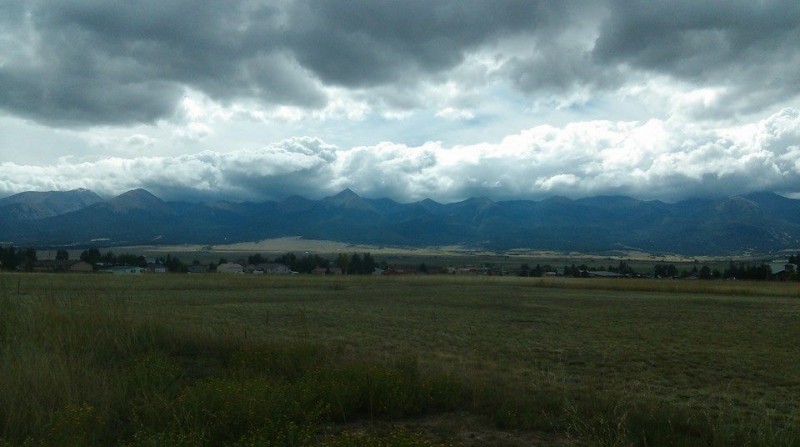 I rolled into Westcliffe on the afternoon of Saturday, September 5, in building weather, to meet up with Sean Flohr for a planned Sunday climb. Based on reports that massive renovations and boulder removal had been performed on the same nasty Colony Lakes Road that had reared its ugly head against my Jeep just a few weeks prior, I felt confident that things would be different this time. Slow and steady, navigation was much simpler. The section that had turned me back earlier was surprisingly tame, and dozens of problem boulders could be seen off to the side. Just past 4:30 PM, after reaching the upper trailhead, we set off for Colony Lakes. We didn't quite make it. We faced dwindling light, steady rain, and my pace was extremely slow, because I thought it would be a neat idea to carry extra items that didn't fit in the pack, and lots and lots of water, in an old hand bag, even though I knew that Sean carried a filter. "Pack light and be efficient". I had camped before and I knew this. I made a weird mistake, this does occur from time to time. I learned from it, and will never repeat this mistake in the future. Hard to know exactly how far we got, but I think it was about 1.5 miles, with perhaps an 800-foot gain. Not ideal, but it would have to do.  High winds throughout the night, with a frontal passage, disrupted sleep. Two hours is my estimate, and that's actually the norm for me when camping. Due to a favorable Sunday forecast, we opted for a start just before dawn, despite being well short of the lakes. At 6 AM, we were off. September 6, and it felt great to finally have boots on the ground for a climb. Long time coming.  Nearing, and reaching, the ascent toward Broken Hand Pass, I began to feel the combined effects of very little sleep, along with not having done much over the summer. I'm used to not feeling great on an ascent, but my pace seemed really slow and rest breaks were unusually excessive. I was also concerned about growing dizziness, heading into a serious climb. 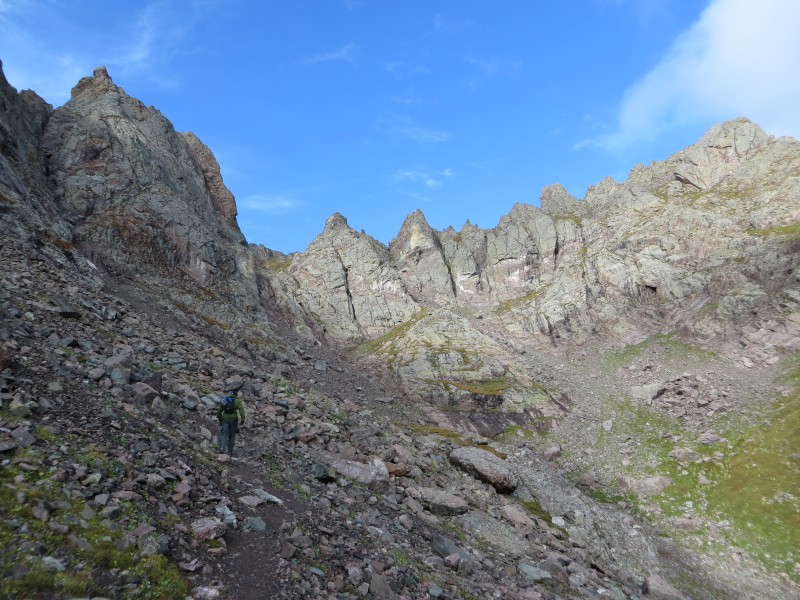 The off-and-on Class 3 climbing commences quickly in that section. I enjoyed it, and felt at home. I always embrace the climbing motion that goes beyond simple hiking, and never dread it in the slightest. I imagined snow in that shaded, north-facing area, given that over 80% of the year, that represents its natural state. I concluded that the ascent to the Pass would be doable, but definitely not a task to take lightly. Ice axe and crampons would be essential; I wouldn't skimp on that if there were any reports of snow in this section. Dry on this day, I also recalled various threads questioning "should I use a helmet on 'x' route". The Needle is definitely in the "Yes" column. Halfway up toward the pass, I sent a fist-sized rock flying toward two climbers just beginning the ascent, who hadn't yet donned their helmets. Later, up the East Gully, I would duck to avoid a smaller stone that had come from who-knows-where, whooshing like a bullet as it flew past my right ear. Crestone rock is relatively solid, of course, and I had never used a helmet on a Class 3 climb before. But everything past Colony Lakes is so steep, these rocks can generate a lot of speed and travel a long ways. I was definitely glad to be wearing one. Steadily, I navigated upward. Shortly past 8, we reached Broken Hand Pass. 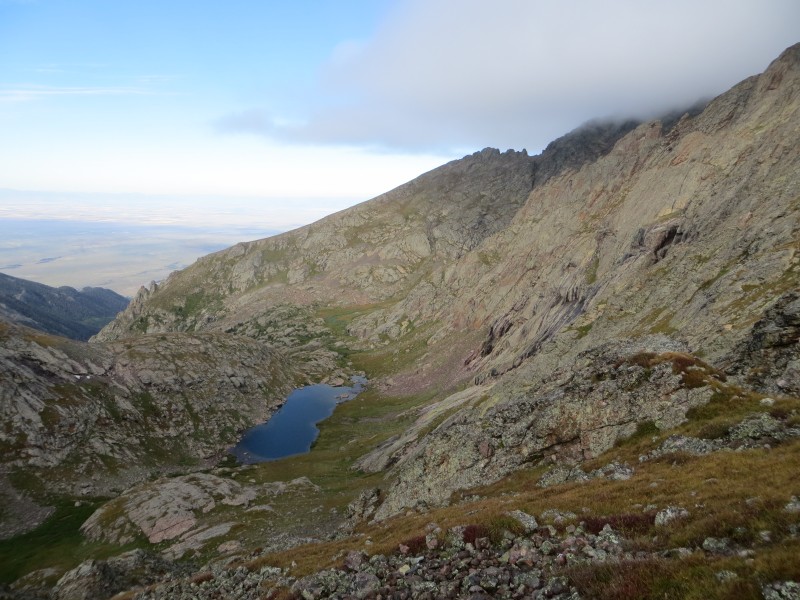 I was wiped out though. Dizziness not subsiding, the higher winds at the Pass seemed to be spinning the world around, and I felt physically ill. I had just ascended 1500 feet over less than a mile, was trying to keep up with Sean, made it to the Pass, but essentially concluded the assessment that I was in decent enough shape to take on the Needle had been incorrect. This had been going on since below tree-line, I was ready to call it and promise Sean that I'd stay put at the Pass while he went to the summit, and I communicated this to him. Mentally, there was substantial anguish on my part though, as I had really been looking forward to this trip. Although wind and clouds seemed to be persistent up higher, the front had clearly passed. Forecasts had suggested that storms would not be an issue today, so we agreed that there was time to take a lengthy break and assess the situation. Sean advised me not to be so concerned with keeping up, and assured me that he was fine with waiting and slowing as needed. Also, he prodded me about "giving up too easily". In other words, he provided motivation to help me continue, and I appreciate that. I prayed, and gazed up towards the Needle, which we really hadn't been able to see since reaching the Pass. 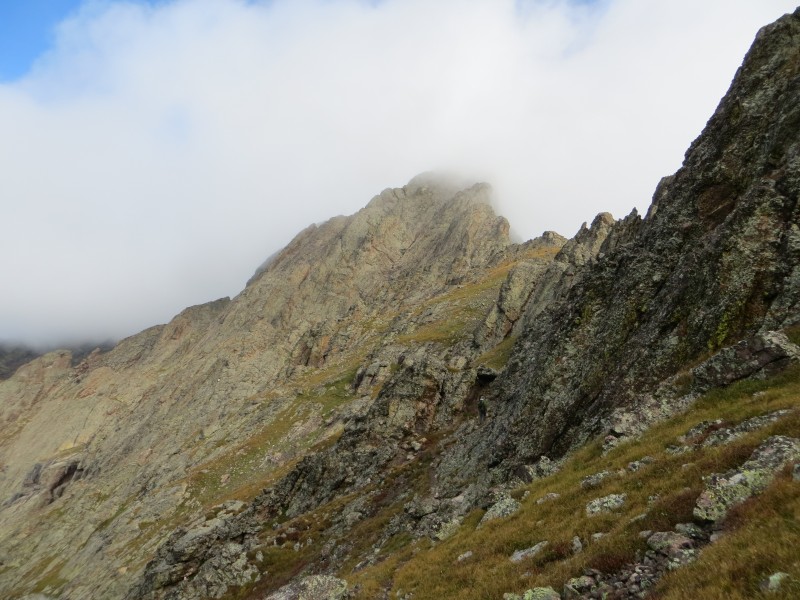 Finally becoming visible, the South Face beckoned right there in front of me. I had travelled 150 miles, teamed up with a climbing partner who wanted us both to succeed, hiked through the rain to pitch a tent, managed to get at least a bit of sleep, and weather seemed fine. I was now staring directly at one of the most exciting standard routes any 14er has to offer, with the summit less than 1500 feet above. Weakness and doubt turned to strength and confidence, and I would not feel tired or weary on this day again, until long after the sun had set and I had almost completed the drive back to Denver. 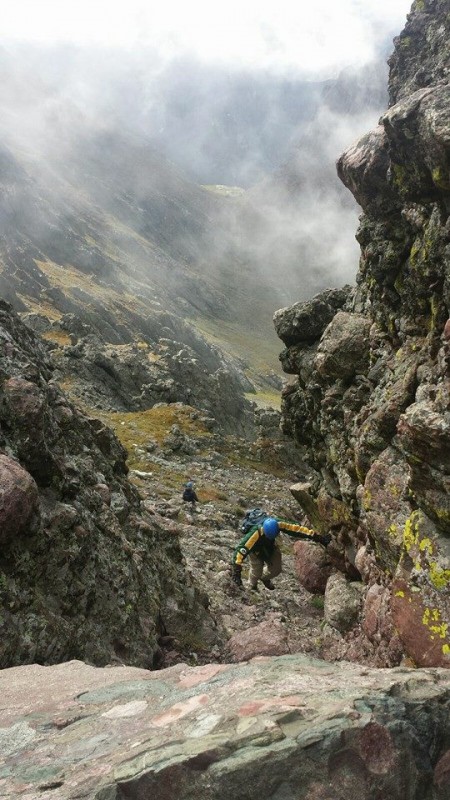 Not long after, we had carefully completed the down-climb to enter the East Gully and we proceeded onward and upward into the passing clouds. 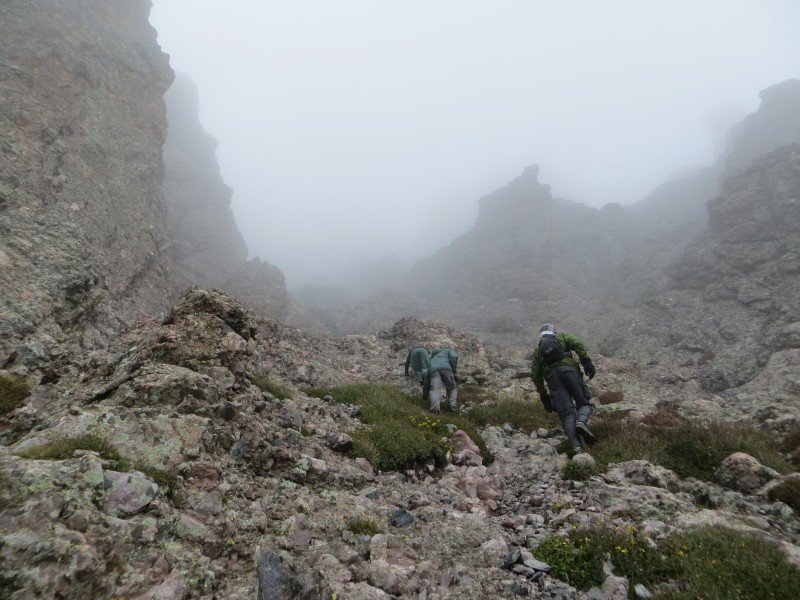 Many have referenced this, but I was in awe at Crestone rock, and how incredibly solid it is. Obviously, not every rock is secure. But there was not one section where I thought "careful, don't drift off course, this could move". The rock is stable throughout. This must have been especially acute to Sean, given that he had climbed Capitol less than a month earlier. 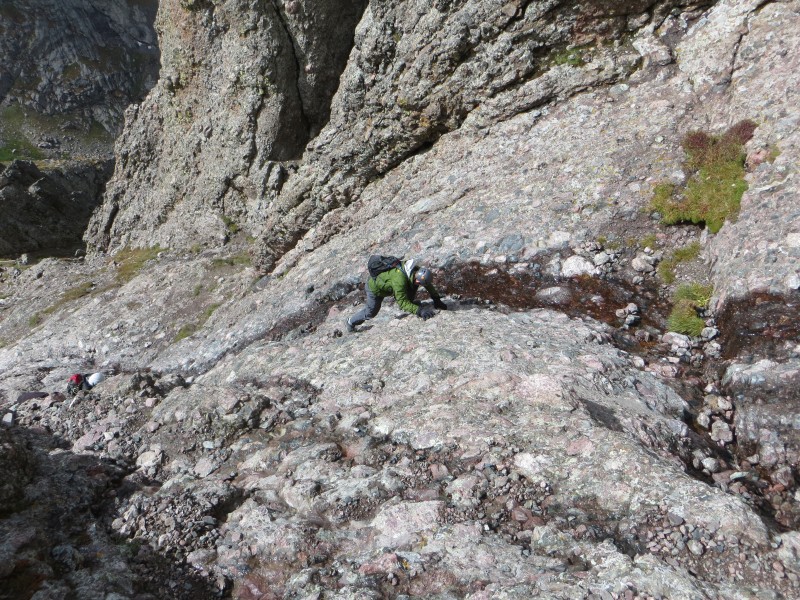 The Class 4 ascent straight up the East Gully looked interesting, but we opted for the standard crossover to the West Gully. One descending climber reported ice up high, confirming the decision already made.  At the base of the rock rib climb to switch gullies, we found the "crack" crossing to be surprisingly challenging. There was a fair amount of water running through, so it basically represented a stream crossing. However, this "stream" slopes downward at over 40 degrees. And, there's a short rock wall on the other side that blocks easy passage. So, getting across involves a quick step and grab of the wall, stepping up and over, and it's done. Footholds and handholds are large, and easily visible. But it is important to get it right, because any backward slip, off the wall, would almost certainly result in an awkward landing and probably a 5 or 10 foot leftward tumble down the steep indentation. A little study and concentration, and we were through it. As for the crux, at the top of the rib. In prior Class 3 climbs (Kelso Ridge, Long's, Wetterhorn), I had never encountered any exposure that gave me even slight pause. In mild to moderate exposure, I tend to walk right by, without even noticing. This one definitely caught my eye. Not for long, but just long enough to caution myself, "don't fall here". Because there aren't great holds in the last 2 ½ feet or so below the top of the rib, the final move involves using the arms / chest to grab the ridge and pull the rest of the body up. 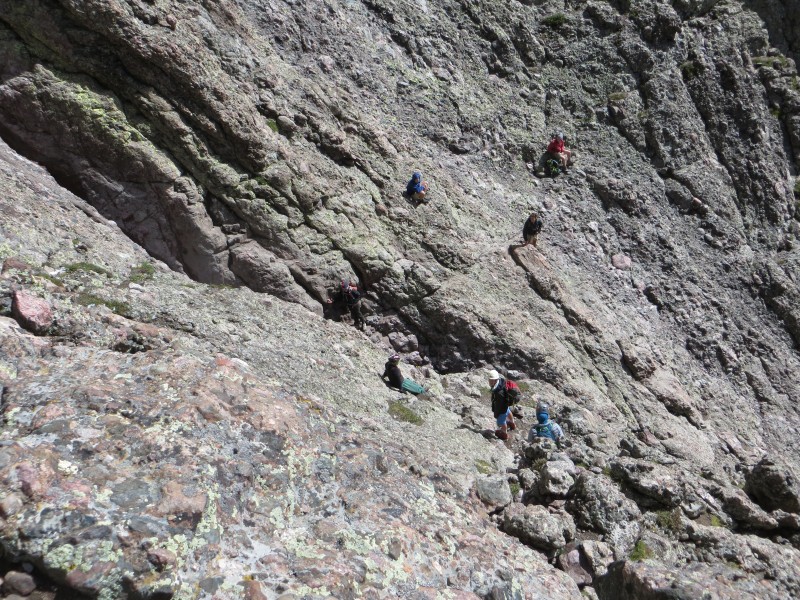 In dry conditions, assuming adequate upper body strength, it's not a difficult move. Tough to simulate exactly, but for anyone who is concerned about it, I'd recommend the following. Find a stable surface at home, about 2 ½ feet high, like a table, bed, desk, or fence. Stand next to it, lock your arms, and place your hands on the edge. Then, pull your left leg up onto the surface. To complete the move, follow with the right leg. If you know that you can effectively pull that off, you've got the Needle crux move. The exposure there is real, for sure. But as is the case for any exposure, focus on the task at hand, it can be overcome. And this is a very reasonable task. Once down into the West Gully at 10:30, I could sense the summit becoming very close at that point, and the most difficult sections were past.  Seemed to me like the rock in the second gully was slightly looser than in the first - just a personal observation. But that's relative, of course, and this was all enjoyable climbing. I needed a short rest near the top - the pitch is somewhat relentless - but soon, the view opened up on the final ramp to the summit.  I knew that within minutes, I'd be standing on a 14er summit for the first time in almost a year, and was thankful for that. Just before 11 AM on September 6, we reached the top of Crestone Needle.  Obviously, the 5 hours from our campsite just below the old 4WD trailhead describes my pace (for this particular day) and not that of Sean, who would have been infinitely faster on his own. As someone else on the summit noted, at least I made it. Crestone Needle had been a goal of both Sean and myself, for the better part of a year, and this was no time to be picky. Perhaps the only thing to complain about was the view of the Great Sand Dunes.  Actually, we couldn't even see Crestone Peak or the traverse. Zero visibility to the south and west, perfect visibility to the north and east. Given what we knew about the weather, it was probably just a westerly breeze pushing some lingering moisture over the peaks, then drying out as the air descended. The atmosphere appeared capped, since these clouds couldn't seem to push above 15 K, and we judged no threat for the descent. But they certainly were persistent. 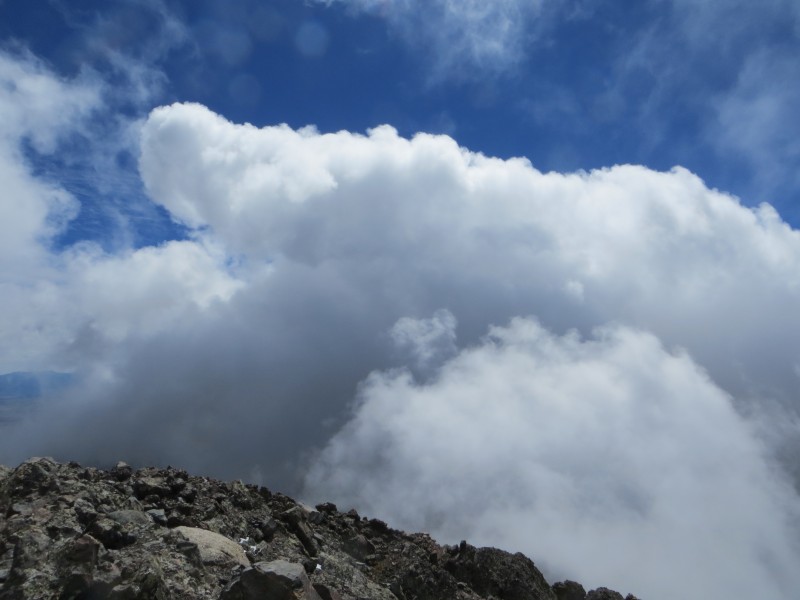 After about 30 minutes, we began our descent. 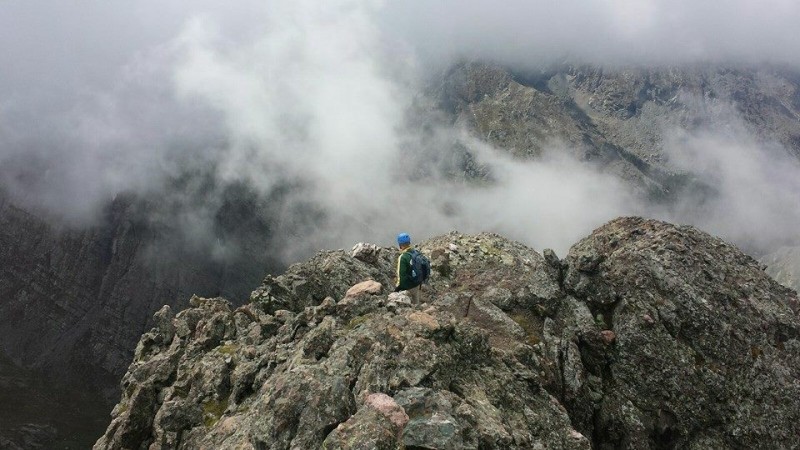 Observing the sky, I deemed the Packer jacket appropriate for conditions, and never took the rain gear out of the day pack. I'd describe the descent as safe, solid, and uneventful. Ironically, the only time that I lost my balance was on loose trail dirt, almost all the way back down at the lakes. Just goes to show that focus should be maintained, even when the "hard part" is over. As others have mentioned, there are now colored markers to signal the crossover point from one gully to the other. Personally, to me, even in the absence of these, the crossover would seem like a tough thing to miss, since the terrain in the West Gully steepens dramatically just past that point, and the rock rib appears to grow taller. But apparently, people have gotten lost here, and having preventive safeguards in place isn't a bad thing. I found the down-climb of both the crux, and the crack at the bottom of the rib, to be much easier than on the ascent. In both cases, the reason was due to stepping down onto a solid and easily visible foothold, as opposed to up and away. Arms were needed for stability, but each move seemed much more simple and natural on the way down. 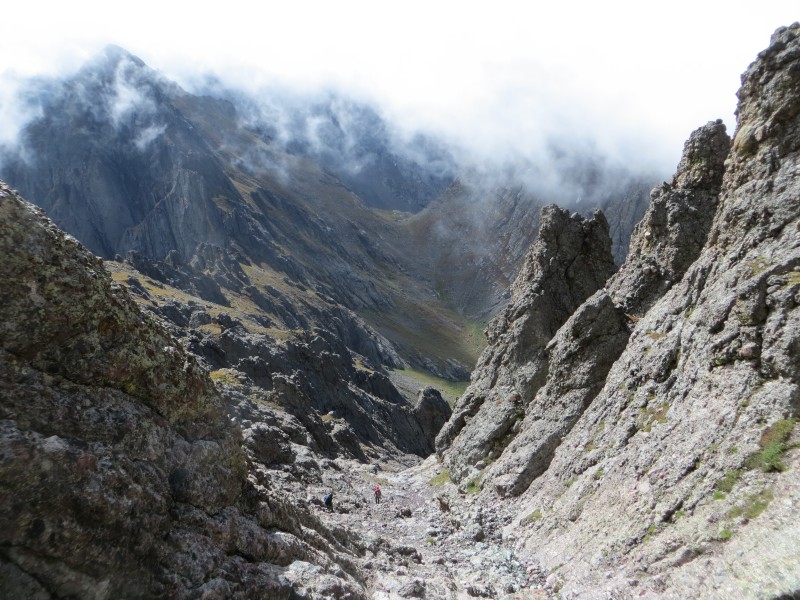 Predictably, by the time we returned to Broken Hand Pass, skies were crystal clear at the summit. 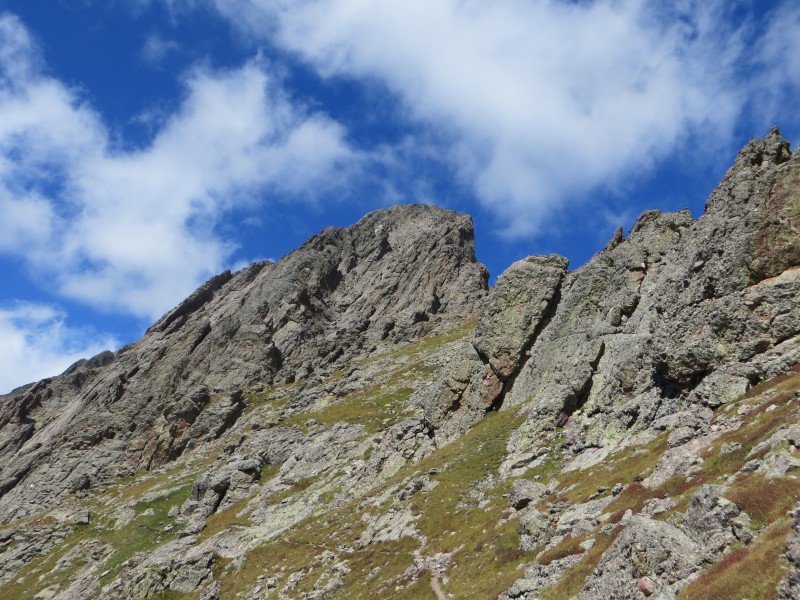 This represented one of those rare situations where mountain weather improved as the day went on, as opposed to the other way around. But even in the morning, conditions were fine; just breezy at the Pass and harmless clouds at the summit. Until recently, I've had a tendency to overreact at the sight of a few clouds, and I was pleased that I didn't gravitate toward that in the slightest on this trip. I'm still conservative by nature, but there's a lot to be said for trusting a favorable forecast, observing what the clouds are doing, and following instincts. In terms of excitement, challenge, satisfaction, the Needle definitely tops the list of what I've done so far. I really enjoy Class 3 climbs, and never felt overwhelmed by anything I encountered. Again, the rock is unbelievably stable throughout; areas of exposure are so much easier to deal with when that's the case. Also, I'm glad that I had completed a few other Class 3 climbs before this one. The Needle contains a large amount of sustained climbing at a steep pitch, the likes of which I hadn't seen before (in terms of consecutive time). However, breaking down each individual movement, I had experienced all of that (albeit smaller doses) on previous climbs. Having prior experience to draw on, helped immensely with fostering confidence and not over-thinking. I'm a huge proponent of building familiarity and then testing limits. I left the Needle with the feeling that mentally, and physically, I can probably handle even more. Maybe Class 4? I'm still open to whatever the future holds. Now, if I could just conquer those walk-up issues . . . As for the 2015 summer season in which just one singular 14er summit was reached, I'm not angry or frustrated, and I've learned along the way. First, I was overwhelmed by my own agenda. July rolled around, and I felt I was just "going through the motions". Then, each disruptive situation thrown my way in the planning stages caused me to evaluate, "why am I doing this". In short, I will continue on, but broad goals like "finisher" or "(x) number of summits this year" are off the table. Too often in recent years, the whole process (from planning to hiking) has felt like a tired, tedious, boring routine. No point to being in the mountains if that's the case. In the future, I need to appreciate and treasure every single trip, just as I enjoyed the Needle. I realize that now. Second, I can be a better hiking partner. As I referenced, Sean helped motivate me to continue in a time of great struggle. I've asked myself, "would I do that for someone?" A quick analysis of four situations where I actually did find myself in this role determined a resounding "No" answer. Not that I behaved terribly, but in each case, I essentially just stood there with my arms folded. Sean, on the other hand, understood the situation, displayed flexibility in dealing with it, and made a few quick but well-timed motivational statements. In the end, it made a difference. This is the type of model in teamwork that I want to follow. Third, I found satisfaction in appreciating the accomplishments of others. One of my other regular hiking partners, Mark Alderton, has been wanting to attempt a Class 3 peak for a few years, and in August, he reached the summit of Long's. Although I was not with him, it was exciting to hear his first-hand account, and gratifying to know that my 2013 trip report assisted him. And, an injury kept me from accompanying Sean on his Capitol Peak climb, something I had really been looking forward to. As I viewed the pictures he shared, I was expecting to feel heartbroken because I wasn't there. But there was none of that. Instead, I only felt happiness. Nice to see people who I've spent time with in the mountains accomplish meaningful goals. Finally, I'm thankful for what I was able to do this summer. In a late May attempt of Columbia, I experienced true snow conditions up high for the first time, and was able to capture several beautiful photos of winter scenes above tree-line. In July, I hiked to Chasm Lake with my youngest sister, who I hardly ever see. Later, there was an interesting afternoon trek up Twin Sisters with Mark. And of course, I deeply appreciate the one 14er I did climb this summer. How could I not, given that it was the Crestone Needle.  |
| Comments or Questions | ||||||||||||
|---|---|---|---|---|---|---|---|---|---|---|---|---|
|
Caution: The information contained in this report may not be accurate and should not be the only resource used in preparation for your climb. Failure to have the necessary experience, physical conditioning, supplies or equipment can result in injury or death. 14ers.com and the author(s) of this report provide no warranties, either express or implied, that the information provided is accurate or reliable. By using the information provided, you agree to indemnify and hold harmless 14ers.com and the report author(s) with respect to any claims and demands against them, including any attorney fees and expenses. Please read the 14ers.com Safety and Disclaimer pages for more information.
Please respect private property: 14ers.com supports the rights of private landowners to determine how and by whom their land will be used. In Colorado, it is your responsibility to determine if land is private and to obtain the appropriate permission before entering the property.
